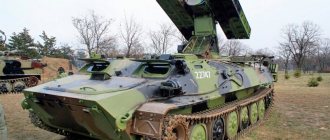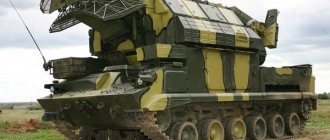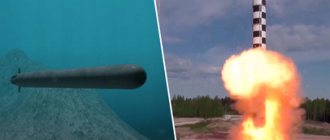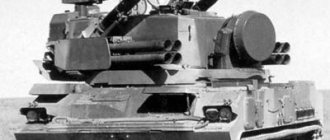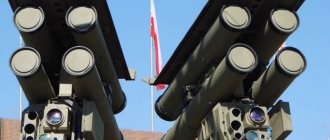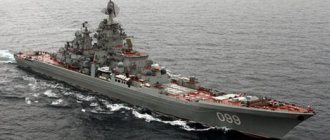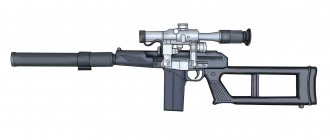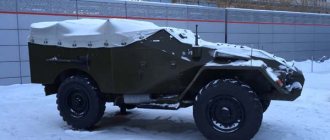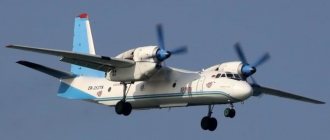Man-portable anti-aircraft missile system 9K338 "Igla-S"
Functionally, the 9K338 Igla-S complex includes the following components:
- combat weapons (see) consisting of: 9M342 missile in a 9P338 tube with a ground-based power source 9B238-1 (9B238);
- starting mechanism 9P522;
- mobile control point 9В866-2;
The difference between the Igla-S complex and the prototype lies in the increased firing range (up to 6 km), the increased power of the warhead (both in terms of the mass of the explosive and the number of fragments) with an almost unchanged weight of the missile itself, in the effectiveness of highly protected air defense systems for air targets.
When creating MANPADS, the LOMO association developed the noise-resistant seeker 9E435. The use of two photodetectors operating in different spectral ranges in the homing head (GOS) made it possible to ensure selection of thermal interference. In addition, a so-called “displacement circuit” has been introduced into the homing head, which ensures the generation of control commands to the missile’s steering gear when approaching a target in such a way that the missile deviates from the guidance point located in the nozzle area to the center of the target, i.e. into its most vulnerable units. According to the developers, this seeker has record-breaking vibration sensitivity and shock resistance characteristics.
The Igla-S MANPADS is the first to use a non-contact target sensor in a missile of this class, which ensures detonation of the warhead when flying close to the target, which happens when firing at small targets. At the same time, the problem of not only introducing a non-contact target sensor into the warhead, but also its optimal operation with a contact fuse has been solved. This is achieved by introducing a certain delay for the detonation of the warhead after the non-contact target sensor is triggered. If during this delay time the contact sensor is triggered, then the operation from the non-contact sensor is blocked, and the warhead is detonated according to the contact detonation algorithm. So, for example, when shooting at an airplane (large target), the delay is set deliberately large, because when a missile flies relative to the structural elements of the aircraft, the non-contact sensor will work, but detonation of the warhead in this place will be ineffective, during the delay time, the missile will approach the aircraft body and the warhead will be detonated by the operation of the contact sensor, if this does not happen, then after a while delays, the warhead will be blown up. It should be noted that the delay times in the rocket are set automatically, depending on the operating modes.
The missile's dimensions and weight restrictions require the use of a relatively small warhead with maximum efficiency. Increasing the effectiveness of hitting air targets was achieved through buried contact detonation of combat equipment with adaptation of the depth level to the speed of encounter with the target. Russian specialists solved this problem by creating a “smart” fuse, which, having received information about the missile hitting the target, waits for information from the penetration sensor (there is one) of the warhead into the skin of the aircraft and, taking into account the time of receipt of these signals, issues a command to detonate. As a result, a small MANPADS warhead causes great damage to the aircraft.
To increase the effect of the warhead, the solid propellant charge of the main engine is made of a material capable of exploding from the detonation of the warhead. Such a solution, which despite its simplicity has not yet been reproduced abroad, made it possible to sharply increase the efficiency of firing MANPADS on a collision course in the affected area by 1...3 km, i.e. the most likely area where the missile will meet the target.
After the rocket leaves the launch tube, the powder control engine begins to operate, turning the rocket to the lead point without human intervention.
The MANPADS have additionally been equipped with a removable night vision sight (NVG) 1PN72M "Mowgli", which allows the use of MANPADS in night conditions, ensuring the detection and identification of targets by an anti-aircraft gunner, aiming and tracking the target before launching a missile. Considering that night raids have recently become a common occurrence during combat operations, the presence of night vision devices significantly expands the capabilities of the complex.
High continuity in the operation of Igla-S, Igla-1 and Igla has been maintained. The dimensions of the new MANPADS, seats for mounting them and package dimensions remain the same. The missile of the Igla-S complex can be stowed in the existing stowage areas of previous missiles and installed on launchers previously created for the missiles of the Igla-1 and Igla complexes. The launching mechanism of the Igla-S MANPADS ensures the launch of the Igla-1 and Igla MANPADS missiles, and the launching mechanism of the Igla complex ensures the launch of the Igla-S complex with virtually no restrictions. The Mowgli NVG contains fastening elements that allow it to be installed on the Igla-1 and Igla complexes.
The Igla-S MANPADS maintains the following order: preparing combat weapons for firing, performing operations during combat work, and maintenance. Thus, a trained anti-aircraft gunner does not need to undergo retraining to work with the new complex. In the educational process of training new anti-aircraft gunners for Igloy-S shooting, training simulators created for the Igla complex can be used. At the same time, a new cool universal complex simulator “Konus” has been created for the Igla-S MANPADS to teach and train anti-aircraft gunners in the skills of detecting, aiming and launching missiles at various types of targets on oncoming and catch-up courses. It includes training facilities not only for the Igla-S missiles, but also for the Igla-1 and Igla missiles.
MANPADS "Igla-S" operates reliably in conditions of extreme temperatures and high humidity (up to 98%), with sudden changes in ambient temperature and condensed precipitation, after immersion in water (to a depth of 0.5 m for half an hour) and rise to in an unpressurized aircraft cabin to an altitude of up to 12 km, after long-term transportation by any type of transport, including cars and tracked vehicles, on any type of roads and off-road. When packaged, combat weapons can be dropped from a height of up to 2 m onto a concrete base, while they remain suitable for further combat use. The combat equipment of the complex allows exposure to random wide-band vibration and repeated mechanical shocks (up to 35g). They are resistant to dust, frost, dew, salty sea fog, cyclic exposure to temperatures (with an instantaneous change from +50°C to -50°C and back), solar radiation, rain and low atmospheric pressure, they are not afraid of the effects of mold fungi , marine flora, ants, termites and rodents.
The missile can be launched by an anti-aircraft gunner from the shoulder from any unprepared open area, from a trench, the body of a moving vehicle, from a railway platform and even from a reservoir.
The designated service life of the complex's combat weapons in the Russian Army when stored in heated rooms in boxes, 9P522.55.000 is ten years, including seven years in unheated rooms, of which four years in field conditions when stored in boxes, including two years military exploitation outside the boxes.
To increase the efficiency of using the Igla-S MANPADS, a set of means for supporting shooting at night (SOSN) 9S520 has been developed. This kit can be used for all types of man-portable air defense systems. This allows the squad commander of anti-aircraft gunners to receive notification of air targets, carry out target distribution between the gunners and then, after detecting an air target, carry out aiming, tracking, homing head acquisition and missile launch. SOSN 9S520 provides:
- reception of telecode notification information from control points of the following types: “Assembly” (9S-80M), “Rangier” (9C737), PU-12 (9S482M6, M7), MP-22R, P-19 radar (1RL134Sh3);
- displaying on the light indicator of a portable electronic tablet (PEP) the location of targets with signs of state affiliation and composition;
- introduction of topographic geodetic reference into the PEP, including space reference;
- orientation of support devices along magnetic azimuth;
- recalculation of the current coordinates of targets displayed on the PEP to the location of the anti-aircraft gunners;
- targeted transmission via cable over a distance of up to 50 m of target distribution information and the current target designation value to anti-aircraft gunners in azimuth and range to the target;
- search, detection and targeting of MANPADS at air targets at any time of the day;
- increasing the probability and range of target detection at any time of the day;
- physical and psychological relief of the anti-aircraft gunner while on combat duty and during combat;
SOSN 9S520 contains:
- a portable electronic tablet, including a radio station and a microelectronic terminal, designed to convert telecode information received from a control point of the 9S482M4 type, display on the indicator the location of targets with signs of state affiliation and the composition of targets (single-group), target distribution and issuing target designation to the support device;
- a group of support devices spaced at a distance of up to 50 m from each other (see), each of which is made in the form of a folding tripod and a stand with fastening elements for MANPADS and is equipped with individual target designation means connected by separate communication lines to a microelectronic terminal;
- individual control equipment with an angular position sensor, electronic units, and a 1PN72M night vision sight. This allows the anti-aircraft gunner to receive information about the appearance of an air target, the direction of its movement and range;
- special packaging for storing, carrying and transporting (by all types of transport) the components of the SOSN.
The time of continuous operation from one set of autonomous power supplies is at least 12 hours, from onboard ones - without limitation.
In 2009 A new version of the SOSN kit, 9S935 “Barnaul”, developed by Izmeritel OJSC (Smolensk), entered service.
The Igla-S MANPADS is coupled with the Dzhigit support-launcher, a set of control equipment and launch modules Strelets, and a Komar turret.
Tactical and technical characteristics of the Sosna air defense system
— Developer: JSC Precision Engineering Design Bureau named after.
A. E. Nudelman" - Chief designer: Oleg Korotkov, since 2011 - V. V. Ukleev - Years of development: 2005—present. c. - Start of testing: 2013 - Status: state tests completed in 2020 - Chassis: MT-LB - Crew: 2 people - operator and driver
Armament of the Sosna air defense system
— 12 pcs. SAM 9M340 Sosna-R - Missile weight in flight (in TPK), kg: 30 / 42 (28 / 38) - Caliber before and after missile separation, mm: 130 / 72 - Maximum missile speed, m/s: 900 - Maximum overload, g: 40 - Guidance system: laser beam
Damage range of the Sosna air defense system
— in range: 1.3–10.0 km; in height: 0.002–5.0 km
Range for automatic target tracking (at MDV = 15 km, p = 80%), km:
- airplanes: 16-30 - helicopters: 10-14 - cruise missiles: 8-12 - ground armored objects: 8
— Round-the-clock use: ensured
— Reaction time (from the moment of target detection), sec.: 5—8- Reload time, min.: 10.0 (12.0)
— Operating modes: autonomous and with centralized control
— Horizontal pointing angle: circular; - Vertical pointing angle: from −5 to +82°
Guidance system and fuses
Design bureau engineers did their best to reduce the weight of the Igla portable complex. MANPADS are conceptually a compact weapon; they are intended for use by one fighter. The mass of the high explosive contained in the missile's fighting compartment is the same as that of the Strela (1170 g), but its energetic (explosive) power is much higher. In addition, a completely logical solution was to use unspent fuel as an additional destructive force, for which a special device called an explosive generator is used. At its core, it is a detonator that is triggered when the main charge is detonated and transforms the relatively slow combustion of fuel into an instant chemical oxidation reaction releasing a huge amount of energy. There are two fuses: contact (activated by direct contact) and induction (capturing the target’s magnetic field at a distance). BZU type – high-explosive fragmentation.
Performance characteristics
Let's compare the main indicators of the main version of the Igla, as well as its simplified version, and the famous American MANPADS "Stinger", which also appeared in service in the 1980s.
| 9K310 "Igla-1" | 9K38 "Igla" | FIM-92C “Stinger” | |
| Total weight, kg | 39 | 39 | 42 |
| Weight of warhead, kg | 1,1 | 1,1 | 3 |
| Maximum range, km | 5 | 5,2 | 4,5 |
| Maximum rocket speed, km/h | 2160 | 2052 | 2700 |
If you believe these indicators, then at the time of its appearance the Stinger was distinguished by high power and was a faster missile. But it is worth noting that American engineers did not provide for fire control via an electronic tablet. The Stinger's homing head was also equipped with a system to counteract heat traps, but, basically, it was achieved by complex information processing systems.
In terms of combat, MANPADS can be considered equivalent - although no one has yet succeeded in sparking a civil war or turning the tide of a military campaign with the help of one Stinger.
It is noteworthy that the ease of operation and adoption of both American and domestic MANPADS stemmed from the fact that they were initially considered as a means of conducting special operations and guerrilla warfare.
The British Blowpile MANPADS demonstrated the opposite approach. It was superior to all analogues in terms of noise immunity and was all-weather. But he had a more complex and lengthy training program for rocket scientists, who must have an appropriate level of qualifications and constantly maintain it at the proper level.
The portable air defense system “Igla” became an important achievement of the domestic industry and rightfully enjoyed high popularity (“Igla” was chosen by the majority of countries that did not buy the “Stinger”).
But at present, this development is becoming obsolete.
Application experience
The armies of more than four dozen countries are armed with the Igla anti-aircraft man-portable air defense system. Its use by Iraqi troops in 1991 caused the loss of several aircraft to the coalition air force, which demonstrated the high effectiveness of this type of Russian weapon even in conditions of almost complete suppression of air defense systems and air supremacy of the attacking side. Over the past two decades, many armed conflicts and wars have arisen in different regions of the planet. In most of them, one side or another used Igla MANPADS. Photos of militants and government soldiers with the characteristic "pipes", as well as damaged and destroyed aircraft, clearly illustrate the lethal power of this relatively small air defense weapon.
In post-Soviet history, the popularity of the Needle can only be rivaled by the famous Kalashnikov. We know about the last major contract for the supply of a large batch of these complexes for the Malaysian armed forces. The system's design continues to be improved, which has led to an increase in the combat use radius of the Igla of the Super modification to six kilometers. These MANPADS, as well as new, still secret models, will completely re-equip the Russian army in the near future.
Hit not after, but towards
The main disadvantage of the Arrows was their ability to hit targets after they passed over the covered object. Typically, an enemy aircraft could be shot down after it had launched a bombing or missile salvo. Of course, the defending troops could “take revenge” if the anti-aircraft gunners themselves survived. “Arrows” could be used in pursuit, and the army demanded a weapon that could hit attacking aircraft on a collision course, preventing possible damage.
In some cases, using the factor of surprise, it was possible to achieve success, despite this design flaw - by “catching” the enemy and delivering an insidious attack on passing aircraft, remaining unnoticed. So in 1969, Egyptian troops massively used portable Strela-2 systems against Israeli Phantoms flying at extremely low altitudes, destroying six of them in a day. But the enemy also knows how to learn, so soon the effectiveness of using Soviet MANPADS decreased, although their benefits still remained undoubted. They had a psychological impact, forcing enemy pilots to constantly rush from low to high altitudes, never feeling safe anywhere. And yet it was necessary to look for technical possibilities to strike towards, and not after.
Combat use
Radar interrogator in the form of a “C”-shaped superstructure, used by the Slovak Air Force, equipped with Igla MANPADS
- During the civil war in El Salvador, FMLN guerrillas using Igla MANPADS shot down at least one A-37B attack aircraft and one AC-47 fire support aircraft. Due to the threat of MANPADS, the El Salvadoran Air Force had to fly at low altitude, where aircraft automatically fell into the range of small arms fire.
- During the civil war in Nicaragua, soldiers of the Sandinista People's Army using Igla MANPADS shot down a DC-6 cargo plane that was dropping weapons on Contra militants.
- In 1991, during Operation Desert Storm, 4 Harrier aircraft were shot down [ not in the source
] In addition, one F-16C was shot down. - During the Bosnian War, Serbs using Igla MANPADS shot down a French Mirage-2000RN reconnaissance fighter
- On October 31, 1995, Indian troops using Igla MANPADS shot down a Pakistani SA.316 Lama helicopter. Several high-ranking military personnel were killed in the helicopter.
- During the Karabakh war, two Azerbaijani MiG-21 fighters were shot down using Igla MANPADS.
- In Chechnya, four (according to other sources, six) Russian helicopters were shot down, including a Mi-8 with a General Staff commission (13 dead, including two generals), another Mi-8 with high-ranking officials (among the dead were Russian Deputy Minister of Internal Affairs M Rudchenko and deputy commander of internal troops N. Goridov) and presumably a Mi-26 transporting military personnel (116 dead, according to other sources it was shot down from a different type of MANPADS). The Wahhabis bought a total of eight Igla MANPADS in Georgia. In 2003, during the operation, three Igla MANPADS of militants were seized, and several organizers of attacks on helicopters were destroyed and arrested. In 2005, the last Igla was confiscated from the militants.
- Used by the Iraqi army against coalition troops since 2003. It is known that on November 7, 2003, an American UH-60 Black Hawk helicopter was shot down using an Igla MANPADS.
- On January 25, 2014, an Egyptian military helicopter was shot down in the Sinai Peninsula. The group Jamaat Ansar Bayt al-Magdis claimed responsibility for the attack.
- During the civil war in Syria, at least two aircraft were shot down (a Su-24 bomber and a Mi-17 helicopter).
- Armed conflict in eastern Ukraine. Used by rebels of the LPR and DPR against the armed forces of Ukraine.
- On November 12, 2014, the Azerbaijani military shot down an Armenian Mi-24 helicopter in a training flight in the area of the line of contact between troops.
- On April 2, 2020, the Armenian military shot down an Azerbaijani Mi-24 helicopter in a combat flight in the area of the line of contact between troops.
- On May 13, 2020, armed formations of the Kurdish PKK shot down a Turkish AH-1W Super Cobra helicopter.
Sources
- ↑
- . rbase.new-factoria.ru. Retrieved November 29, 2020.
- (unavailable link). Retrieved February 22, 2010.
- . ru.uos.ua. Retrieved April 18, 2020.
- ↑. Of. KBM website. Retrieved January 20, 2012.
- ↑. Of. KBM website. Retrieved January 20, 2012.
- The Military Balance 2010. - P. 245.
- The Military Balance 2010. - P. 294.
- The Military Balance 2010. - P. 70.
- The Military Balance 2010. - P. 187.
- The Military Balance 2010. - P. 296.
- The Military Balance 2010. - P. 99.
- The Military Balance 2010. - P. 433.
- The Military Balance 2020. - P. 205.
- The Military Balance 2010. - P. 360-363.
- The Military Balance 2010. - P. 258.
- The Military Balance 2010. - P. 251.
- The Military Balance 2010. - P. 412-413.
- The Military Balance 2010. - P. 414.
- The Military Balance 2010. - P. 78.
- ↑
- The Military Balance 2010. - P. 18.
- The Military Balance 2010. - P. 417.
- The Military Balance 2010. - P. 88.
- The Military Balance 2010. - P. 420.
- The Military Balance 2010. - P. 90.
- The Military Balance 2010. - P. 276.
- The Military Balance 2010. - P. 369.
- The Military Balance 2010. - P. 93.
- The Military Balance 2010. - P. 223.
- The Military Balance 2010. - P. 190.
- The Military Balance 2010. - P. 425-426.
- The Military Balance 2010. - P. 272.
- The Military Balance 2010. - P. 159.
- The Military Balance 2010. - P. 160.
- The Military Balance 2010. - P. 331.
- (unavailable link). Retrieved October 27, 2014.
Tricks vs. cunning
The main channel for guidance of anti-aircraft missiles is traditionally considered to be the thermal trace left by the engine of the aircraft. This method of determining the direction of a projectile was relatively simple, but had serious drawbacks. Immediately after the first cases of effective use against aircraft, devices appeared designed to mislead thermal location systems, which were fired squibs that created a false target. Therefore, it was decided to equip the Igla MANPADS with a two-channel IR guidance head equipped with photodetectors. The development of a system capable of distinguishing a real aircraft from the heat signature of a heat “trap” took an extra seven years, but was crowned with success. It turned out to be technically difficult; it is enough just to mention that the main photodetector, after placing the projectile in the firing position, is cooled to a very low temperature, close to absolute zero (-200 ° C). As a result of these efforts, an automatic system equipped with logic circuits compares the readings of the two sensors. And if the signal level of the additional channel is lower than the main one, then the target is determined as a distractor, and the search is carried out until the missile sees the true object.
There is another important technical issue, the solution of which has significantly increased the combat effectiveness of the Igla MANPADS. The survivability characteristics of modern attack aircraft depend on the location of the projectile impact, and the nozzle is not the best option, so the guidance algorithm provides an additional option that involves changing the direction vector of the missile (turnover) at the final part of the trajectory so that the impact falls on the fuselage. To carry out this maneuver, additional maneuvering engines are provided in the projectile design.
Government assignment to S.P. Invincible
Another drawback that Strela had and which the creators of the Igla MANPADS sought to avoid was the insufficient explosive power of the warhead. Not all hits on the target guaranteed its destruction or even causing significant damage. The survivability of attack aircraft increased, the nozzles into which rockets with a thermal guidance head were directed were made of materials that could withstand strong thermal and baric influences, and the aircraft were often able to return to their airfield, and after repair they again posed a threat. The effect of “washing out” the jet stream of the blast wave and the flow of damaging elements also had an effect. Something had to be done about this.
In 1971, the USSR government decided to create a new complex capable of fighting the most modern and promising tactical-level air attack weapons at that time that a potential enemy could have. The Kolomna Machine-Building Bureau became the head enterprise of the project, related work was carried out by other organizations (TsKB of Apparatus Engineering, Research Institute of Measuring Instruments and the Leningrad Association LOMO). The main leader of the new development quite naturally became Academician S.P. Invincible. The new weapon is called the Igla MANPADS. The characteristics (in terms of target speed, altitude and probability of destruction) should, according to the government order, significantly exceed those of Strela-3 (the latest modification).
